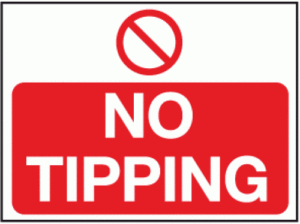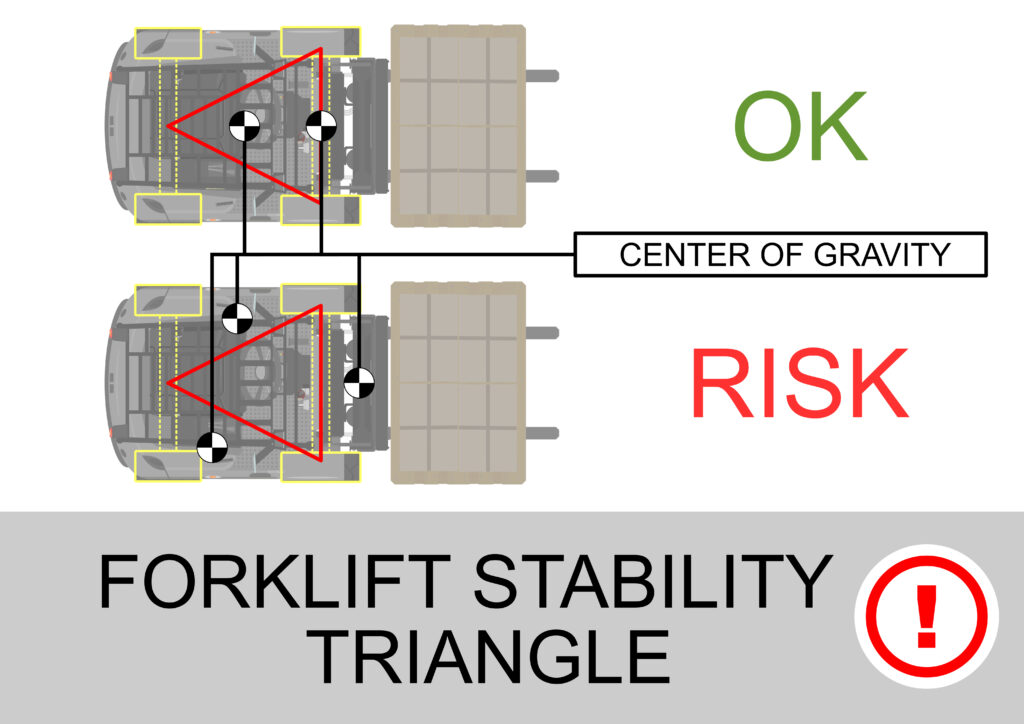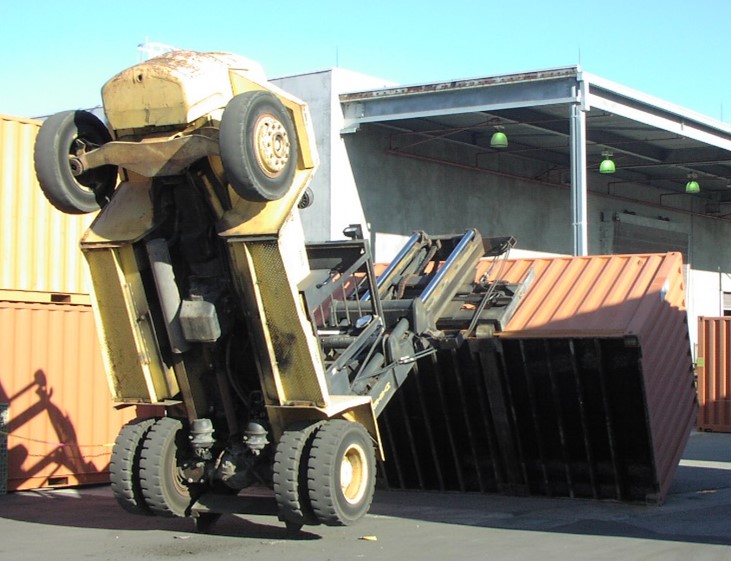That is always good advice to follow if you are a forklift driver! Operating a forklift can be a dangerous occupation. There are approximately 1 million forklifts (powered industrial trucks) in the US workplace today, and it is estimated that just over 10% of those are involved in some type of accident every year. Forklift accidents result in dozens of deaths and thousands of non-fatal injuries annually. About one out of every four of those accidents involves a tipping or overturning forklift, making this the most common type of industrial truck accident. Forklift tip-overs are the second leading cause of fatalities in industrial settings such as factories and warehouses according to OSHA.
Having a good understanding of the forklift “stability triangle” and how the forklift’s center of gravity (CG) can be affected by changes in loading, speed, or the operating environment is vitally important to help prevent tip-over accidents.
The stability triangle is actually a 3D pyramid,with its triangular base typically running horizontally between the mid-point of the forklift’s rear axle and extending to each of the front wheels. As you move vertically, the pyramid narrows, which translates to decreasing space where the combined forklift and load center of gravity must remain to ensure overall stability. The weight of the load being transported may be less than the maximum rated static loading for the forklift, but once the forklift and the load start moving, the position of the combined center of gravity also moves based on loading and operating conditions. Below is a list of common reasons for forklifts to overturn. In all but the last one, the action causes the combined center of gravity to move outside of the stability triangle to make a tip-over possible.
- Excessive speed,
- Operating improperly on uneven or inclined surfaces,
- The carried load exceeds the forklift’s rated load capacity,
- The load being transported has been raised too high or shifts,
- Accelerating too quickly or braking suddenly,
- Poor or inadequate maintenance.
Excessive speed can be dangerous whether a forklift is carrying a load or not. When you combine speed with uneven or inclined surfaces, or making a turn, the odds of a tip-over are greatly increased. Most forklift manufacturers provide a programming feature for setting the maximum operating speed limit at which a forklift can operate. All facilities where forklifts are being used should determine and enforce maximum speed limits based on the operating environment and whether there are other forklifts and/or pedestrians present. MHEDA (Material Handling Equipment Distributors Association) recommends a forklift maximum speed of 8 mph for most common work environments. In areas with high pedestrian traffic, the recommended maximum speed drops to 3 mph.
There is an increased risk of overturning while operating a forklift on an uneven or rough surface due to a reduction in traction which can compromise stability. Improperly operating a forklift on an inclined surface can greatly increase the risk a tip-over due to the center of gravity shifting outside of the stability triangle.
Operators should know the loading capacity of the forklifts they are using as well as the weight of the loads they are moving.
Operators should be aware of how high they can or should raise their loads based on the forklift’s capacity and the operating environment, as well as any risks present should the load shift.
Accelerating or braking too quickly can easily cause an undesirable stability issue. The dynamic forces caused by these actions may cause the forklift’s center of gravity to shift outside of the stability triangle which can result in a turnover.
Poor or inadequate maintenance can contribute to forklift tip-overs. Replacing worn out tires and making sure brakes are working properly are two extremely important actions that help to ensure overall forklift safety. The steering and hydraulic system functioning should be inspected regularly also.
Possibly the most important thing that can be done to help prevent forklift tip-overs from happening is to make sure every forklift operator is properly trained. OSHA estimates that approximately 25% of all forklift accidents are the result of inadequate operator training. It is mandatory that every forklift operator is trained and certified to operate a forklift, and that the performance of each operator is evaluated every 3 years based on the provisions found in OSHA standard CFR 1910.178.l.3. Proper training will help an operator understand how forklifts work, the proper methods for carrying loads, and how changes in the load being carried or even changes in the work environment can impact forklift handling and overall safety. This type of training is effective for reducing the number of forklift accidents and tip-overs.
Understanding how different variables can impact the overall safety and stability of a forklift will help to prevent tip-overs from occurring. This understanding will also help in the analysis of a tip-over accident after it has happened to determine its root causes. If you need an investigation of an incident or injury involving a forklift or industrial truck, please call our experienced mechanical engineering experts at Warren.
Bob Hickman is a Licensed Professional Engineer and Certified Machinery Safety Expert. He has over 30 years of manufacturing and machine design experience in production and quality-driven environments. Bob holds a Bachelor of Science in Mechanical Engineering from Clemson University. Over his 30-year engineering career, Bob has designed many custom manufacturing machines and processes that improved quality, productivity, reliability, and safety. He designed several machines to automate manual processes, replacing inefficient/unreliable manual equipment and has assisted with plant layout/production line planning. He has significant experience with pneumatic systems and components, as well as hydraulics. Bob regularly investigates personal injury, wrongful death, and product liability claims, as well as property damage claims involving machinery and equipment in a variety of environments for both insurance adjusters and attorneys. Bob has an in-depth knowledge of many standards with emphasis on ANSI B11 standards for machine tool safety.





